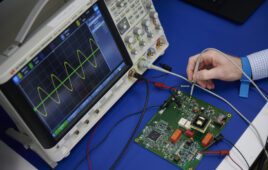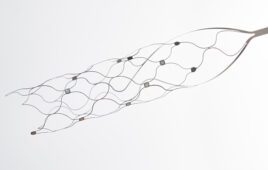Engineering departments have long sought to expand industry partnerships, and medical school departments are following suit. One university offers a new approach to industry-academic collaboration.
John Bischof, University of Minnesota Institute for Engineering in Medicine

Interventional cardiologist Dr. Jason Bartos explains surgical concepts to a Clinical Immersion group over lunch. (Image courtesy of the University of Minnesota)
The robust growth of industry-academia partnerships has helped drive the stunning explosion of the medical device industry over the past 25 years.
And yet, most of us in the medical device space are too constrained in our thinking about academic-industry partnerships. We more or less know how to form collaborations to tackle a particular problem or develop a particular device. But we almost never think about cultivating the fruits that come from just spending time together.
To put this another way, both academic and industry medical device professionals aren’t prone to ask each other, “What have you been thinking about lately?” Nor do we have venues to readily learn about each other’s worlds, even though we’d all benefit enormously from both.
There are several ways to spur academic-industry interaction at what could be called the “brainstorming” level of medical device development. The suggestions below are primarily based on the highly successful Clinical Immersion program managed by the University of Minnesota’s Institute for Engineering in Medicine (IEM), so a short description of that program is in order.
IEM’s Clinical Immersion program
The Clinical Immersion program, which began in 2015, embeds small groups from a company with clinical faculty and residents at the University of Minnesota Medical Center for 2 to 5 days. The industry groups observe and discuss everything the clinicians do: patient rounds, surgeries, clinical meetings, lectures and other day-to-day activities of clinical life. Initial groups focused on general surgery and cardiology; the program has since expanded to include neurosurgery, interventional radiology, wound care and nephrology. Occasionally, some time is reserved for discussion about a device made by the company.
Making it happen
The program’s success shows that there’s a hunger for focused yet informal interaction in both academia and industry. Here’s how medtech industry professionals can initiate more brainstorming collaborations:
- Foster personal academic connections. Cold calling won’t work — everyone in academia is too busy to answer unsolicited email — so start by building on existing relationships. You can deepen these relationships by hosting an informal idea-generating session , a tour of your facility with open-ended conversation, or some other event. You can also ask existing academic connections to help broaden your circle of other professors interested in medical devices.
- Get to know academic leaders. Every major research university has a technology commercialization office that is eager to forge new relationships with industry partners. Look for institutes and centers that list medical translation and commercialization as a key mission. A commonly overlooked resource in universities is department chairs.
- Focus on learning, not producing. Academics in particular gravitate toward pursuing the “why” and conceptual possibilities of devices. Conversation along such lines, along with a serious dive into the biological and procedural nuts-and-bolts of patient care, is enough to shake people out of well-worn mental paths associated with pushing along the development of a medical device.
- Forget profit, even if just for a while. We need to remember that behind the competitive medical device world is a community of common purpose — namely, to improve health for all human beings. By cultivating that community at a conversational level, we all have a lot more to gain than to lose.
You may need to experiment before you find successful approaches: Perhaps something like Clinical Immersion, a local industry-academia day retreat or a presentation followed by discussion over drinks. Anything that brings you exposure to academics to begin real conversation about real needs will build the trust and long-term relationships that are the foundation of fruitful ideas and collaborations.
John Bischof is Distinguished McKnight Professor and Carl and Janet Kurhmeyer Chair of Mechanical Engineering at the University of Minnesota. He is also the director of the university’s Institute for Engineering in Medicine.
The opinions expressed in this blog post are the author’s only and do not necessarily reflect those of Medical Design and Outsourcing or its employees.




